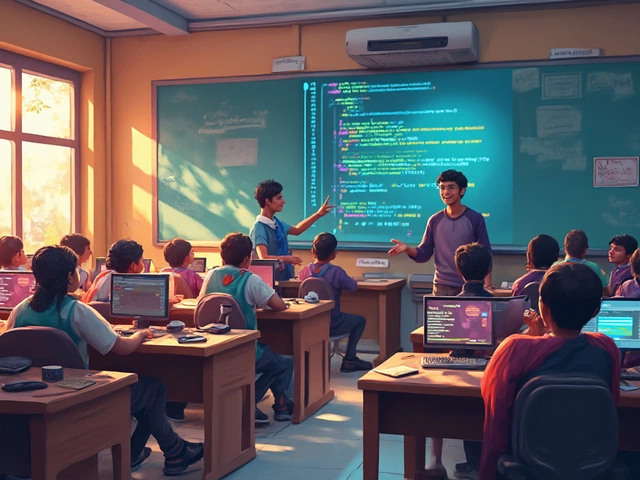Ever thought about coding on your phone? Sounds wild, right? But believe it or not, it's becoming a thing. Thanks to advances in smartphone tech, mobile coding is getting more and more accessible. You’ve probably got a decent camera, a ton of apps, and now maybe a pocket-sized coding powerhouse in your hand.
Let’s start with some apps. You might have heard of SoloLearn and Grasshopper, which are great for beginners. They make learning code feel like a game, with short lessons and practical exercises. Another big name is AIDE, which lets you develop true Android apps on your phone. It's like having a mini Android Studio wherever you go!
- The Rise of Mobile Coding
- Top Apps for Coding on Your Phone
- Benefits and Drawbacks
- Tips for Effective Phone Coding
The Rise of Mobile Coding
Just a decade ago, considering to code on your phone might have sounded like a sci-fi idea. But today, it’s actually happening, and more people are getting into it. Thanks to technological advancements, our smartphones can do much more than just browsing social media or streaming videos.
Why has mobile coding become such a hit recently? Well, for starters, the convenience factor is a huge plus. Imagine you're on a long bus ride or waiting for your coffee—you can easily whip out your phone and start coding. That kind of flexibility makes a big difference for learners and professionals who are always on the go.
Improving Phone Capabilities
Phones have improved massively in terms of processing power and screen quality. Most smartphones today are packed with powerful processors that handle complex tasks. While screens are still relatively small, high resolutions make reading code easier. Also, the touch interface has become more sophisticated, allowing for smoother navigation through lines of code.
Apps Leading the Charge
There’s been a surge in the development of programming apps for phones. These apps have made it easier to get started with mobile coding. From learning platforms like SoloLearn to full-blown IDEs (Integrated Development Environments) like AIDE for Android development, the variety is astounding.
In 2023, studies showed a significant increase in downloads of mobile coding apps. People are appreciating the ability to learn or practice coding from anywhere, anytime.
Stats Table
| Year | Number of Coding App Downloads |
|---|---|
| 2020 | 5 million |
| 2023 | 12 million |
| 2025 (Projected) | 20 million |
This trend hints at how learning and working remotely is shaping the future of programming. It's almost like the younger generations will expect to learn coding on the go, just as they learned other mobile-centric skills.
Top Apps for Coding on Your Phone
If you're itching to get into mobile coding, you've got plenty of apps to choose from. Let's dive into some of the popular ones that can turn your phone into a programming playground. These apps aren't just for show—they're practical tools that help you learn, practice, and even develop real applications.
SoloLearn
SoloLearn is like an interactive playground for coding. Whether you're a new coder or looking to brush up your skills, this app has courses in every programming language from Python to JavaScript. Its community-driven approach means you can learn from others and share your own insights too.
Grasshopper
Ever wanted to learn JavaScript on your phone? Grasshopper makes it super easy! Developed by Google, it offers playful and bite-sized lessons to help beginners get their hands dirty with coding without feeling overwhelmed. The cool thing is it drops you right into coding puzzles—which makes learning fun.
AIDE
Think of AIDE as your mobile Android Studio. It’s a robust app for developing Android apps right on your phone. It's packed with features like real-time error checking, and even supports Java, C++, and more. Got an idea for an app while on the go? AIDE can help you bring it to life without a laptop.
Programmer's Calculator
Sometimes you just need a specialized tool to assist with coding tasks. Programmer's Calculator might sound like a niche app, but when you’re deep in coding, it's a lifesaver. It handles conversions and complex calculations with ease, letting you focus on the more creative parts of coding.
Here's a quick look at some features:
| App | Primary Focus | Community Interaction |
|---|---|---|
| SoloLearn | Learning & Courses | Yes |
| Grasshopper | JavaScript & Puzzles | No |
| AIDE | App Development | Yes |
| Programmer's Calculator | Calculations | No |
Each app has its unique features and advantages, so play around and see which fits your style best. There's no single "best" app for everyone—just the one that feels right for you and your coding journey. Happy coding on your mobile!

Benefits and Drawbacks
Coding on your phone has its bright sides but also some not-so-great parts. Let's break them down.
Benefits of Mobile Coding
- Access Anywhere: With coding apps on your phone, inspiration can strike and be acted on anytime, whether you’re on the bus, at the coffee shop, or chilling at home.
- Learning on the Go: Apps like SoloLearn and Grasshopper make learning feel like a breeze. You can fit in a quick lesson while waiting in line!
- Cost Effective: Many coding apps are free or have affordable subscription models, meaning you can start learning with minimal investment.
- Touchscreen Conveniences: With a phone's touchscreen, some tools are more intuitive. It’s hands-on like that.
Drawbacks of Mobile Coding
- Screen Size Limitations: Let’s face it, coding on a tiny screen can be challenging. Bigger projects might feel cramped.
- Limited Processing Power: Compared to laptops or desktops, smartphones have less processing muscle, limiting what you can build or run directly on them.
- Typing Speed: Touchscreen typing is slower than traditional keyboards, potentially slowing down coding speed, especially for longer projects.
- App Limitations: Full development environments and advanced debugging tools are often not available on mobile apps.
Weighing the benefits and drawbacks can help you decide whether mobile coding fits your lifestyle and goals. It’s all about finding the right balance for your needs.
Tips for Effective Phone Coding
Coding on your phone might feel a bit cramped compared to a full-on computer setup, but trust me, it's way more possible than you think.
Optimize Your Workspace
Start by optimizing your workspace. Sure, your phone screen is small, but you can make the most of it by using landscape mode for more coding real estate. Don't forget to get a solid case with a built-in stand or grab a phone holder. You might also want to invest in a Bluetooth keyboard. Your thumbs will thank you!
Choose the Right App
When it comes to software, pick a coding app that suits your style and needs. Beginners should lean towards apps that focus on education, like SoloLearn or Grasshopper. For more advanced scenarios, AIDE lets you work on full projects right on your Android device.
Manage Your Time
Phone coding is perfect for short bursts. Think of it as a way to fill those little gaps during your day—waiting for a friend? Sneak in a quick coding challenge. Either use a task timer or set short-term goals. This way, you integrate learning seamlessly into your day.
"Coding on-the-go is about fitting learning into the pockets of your life," suggests James Clear, author of Atomic Habits. "Small and daily triumphants can lead to tremendous results over time."
Stay Organized
If you’re juggling multiple projects, organization is key. Use cloud storage like Google Drive or GitHub to keep access to your codes flexible and shareable across devices. This keeps you from feeling lost even with a tiny screen.
| App | Average Rating | Price |
|---|---|---|
| SoloLearn | 4.5/5 | Free with in-app purchases |
| Grasshopper | 4.6/5 | Free |
| AIDE | 4.0/5 | Free with in-app purchases |
These little tweaks can make coding on your phone not just doable, but surprisingly effective.





